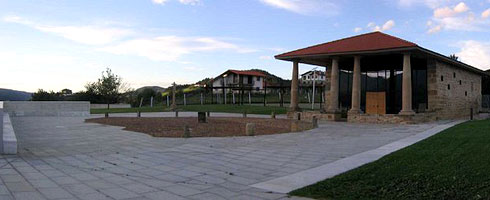Parque Natural de Urkiola · Ayuntamiento de Abadiño
Situación
Menú principal
Any trip to the park would not be completed without visiting Abadiño, a village in the foothills of Mount Urkiola. There, you will find a wide range of services, restaurants, bars, accommodation, etc.
The village’s history is lost in the depths of time. We know from the traditional anteiglesia or town meeting system that Abadiano has been inhabited since time immemorial and came under the historical administrative district of Tierra Llana de Vizcaya. Important prehistoric remains of various settlements have been found there, such as the Bolinkoba caves (Solutrean settlement), Oialkoba (Bronze Age), Astakoba and Albiztei. The best way to discover its history is to visit its main monuments:
Muntsaratz Tower
Thought to date back to the 9th century, it is located in the Muntsaratz district. It is one of the oldest tower-houses and the most important Renaissance building of its type. It is one of Bizkaia's best-known monuments. It was nearly razed to the ground although it has been refurbished.

Gederiaga Complex
It is located on a hill in the Abadiño municipal borough and is in the district of the same name. The San Salvador chapel stands on this hill, which overlooks the valley that is home to the municipal borough. The chapel is famous for being an Oath Chapel that is characterised by the 12 stone seats arranged in a semi-circle around another larger central area, where the Merindad de Durango valley authorities held their General Assemblies. Just a few metres away, there is a large stone cross in the land in front of the chapel. It is made out of sandstone and dates back to 1633. This cross is part of a series of stone crosses to be found in the Duranguesado zone that dates back to the period between the start of the 15th century and the end of the 18th century, as it belong to the Renaissance and Gothic style, even though some works attribute it to the Plateresque style.
Astola Manor House
The Astola Manor House or Astolazubiaurre was one of the political-administrative centres of the Merindad de Durango valley authorities. In 1576, the Merindad bought the building. The court and residency of the local lieutenant was moved there at the same time as the Merindad gaol and archive was set up there. With the passing of time, this house ceased to play such an important role. In 1784, the new Merindad archive was moved to Abadiño Parish Church. In 1843, the Lieutenant of Astola resigned from his post and the gaol was moved to the Lariz Tower. It currently houses the seats of the Medindad del Duranguesado Community, the Friends of Gerediaga Assocation, the Basque Pelota Federation and Euskadiko Herri Eskola.
Abadiño Tower
It is in the Zelaieta hamlet, on the road from Durango to Elorrio. After being destroyed by Pedro de Abendaño in 1443, Iñigo de Abadiño rebuilt it. In the 19th century, it was burnt to the ground, but was rapidly rebuilt with one dwelling less.
Zeletabe Palace
This palace was built by María Zelaieta, originally from Abadiño, and her husband, Pablo Galindez, in 1913. It is now know as the Galindez Palace. It is located on the road from Plaza Txanporta to Plaza San Trokaz. It is in excellent conditions and its outstanding features are its ogival windows.
On 28th December 1990, the Town Council acquired the building to be fitted out as a public facility and carried out the relevant refurbishing works for the building's new use.
Further information at www.abadiano.org2006 - 2007 © Anteiglesia de Abadiño Town Council - All rights reserved